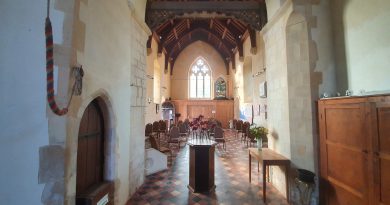Fundenhall – St. Nicholas’s Church
It’s fair to say that this church in the Norfolk countryside isn’t typical of the area in terms of its design and its central tower. There’s something quite magnificent about it though, that tower makes quite a statement. And another statement that this church made was that it was open to the public and seemingly proudly so. Other nearby churches weren’t open and we met someone who commented that the building’s keyholder wasn’t letting them in even though they were only a few doors down. The current Covid-19 situation is inevitably going to cause issues, but these stories of churches remaining firmly closed to other than the select few are perhaps far too common. However, there were no access issues at Fundenhall, it seemed to be a place that the Church of England was proud of.
The glorious central tower is original, dating to the twelfth century, although the top section may be later.
Potential tragedy hit this church in 2004 when it was forced to close due to falling masonry. This Norman period church is not in an area which is surrounded by residential properties and there are multiple other churches within easy walking distance. That put a pressure on the congregation beyond what they might reasonably have been expected to cope with. But, with some ingenuity and support of the Lottery Heritage Fund, individuals and businesses, they were able to get the repairs completed and re-open the building in May 2010. It was no quick fix either, the repair and restoration work cost £250,000. The church was fortunate, if the falling masonry had been twenty or thirty years earlier, then this building might not have been repaired.
The north side of the church, although since Heritage Lottery funding has allowed the construction of a rear car park, entrance is mostly through the south side of the building. The porch is now closed off to the public, but is architecturally of little interest since it was added in the nineteenth century. The bulk of the building, excluding the tower, dates from the fourteenth century.
A now blocked window on the church’s north side.
Since a visit I made to a church last week which pointed out medieval graffiti, I’ve been on the lookout for it. The cross appears to be pretty old to me (I’m not sure that this is a phrase used by professionals, but there we go) and was perhaps once covered in limewash.
I was pleased to see a Norman style doorway, but this according to the listed building record is an actual Norman doorway that is unmoved from its current position.
The inside of that same doorway and that wooden door is of some considerable age.
The beauty of this church wasn’t limited to the exterior as the interior was bright and open. The rood screen might have gone, but the surround (or coving I think it’s called) has survived, so that must be from before the Reformation. Older books, not least Blomefield, suggest that this rood loft was more complete in the eighteenth century and painted work was still visible. There was an extensive nine-month long repair project which took place in 1869, where there was also some re-ordering and so it seems likely that the damage was done then.
A newspaper report from the Norfolk News in 1870 is more generous, talking of the Portland cement used in the chancel and the retiling of the nave with Minton tiles. It’s added that the rood loft was protected by taking it down and moving it to the west end of the church, but there’s an awful lot of “new” things being mentioned in the report, a logical indication of how much has been lost.
The original drawing made by the architect Richard Phipson from that 1870 renovation, with the big new oak benches visible. I wonder where they are today, as they appear to have only been removed in the recent repair work to the church as they’re in George Plunkett’s photo from 1996. There’s an old photo of the interior of the church here.
This is rather lovely, it was funded by the Heritage Lottery Fund and local families, entitled “Reconnecting with Fundenhall’s Fallen” and was created by Kate Munro.
That’s much friendly than a “do not touch” sign, I like it.
Looking back down the nave.
This was the entrance to the rood stairs and also to the tower, a handy advantage in having a central tower. The bells are still in the tower and can be rung, although there was a little incident in 1 August 1885 when John Atkins “let go of the bell rope, fell backwards and expired”.
The font is from the fifteenth century, so that was here whilst the Reformation was taking place and parts of the building were being torn down around it. The location of the font has been moved from its previous place at the rear of the nave.
Some of the old flooring is visible through this panel, although it was a bit misted up and so not entirely clear.
The chancel.
The priest’s door leading off of the chancel.
There were numerous eighteenth century graves in the churchyard, but more of these in later posts. For anyone engaged in the detail of the church’s architectural history, there’s a comprehensive document which was produced in 2007 during the restoration work.




















